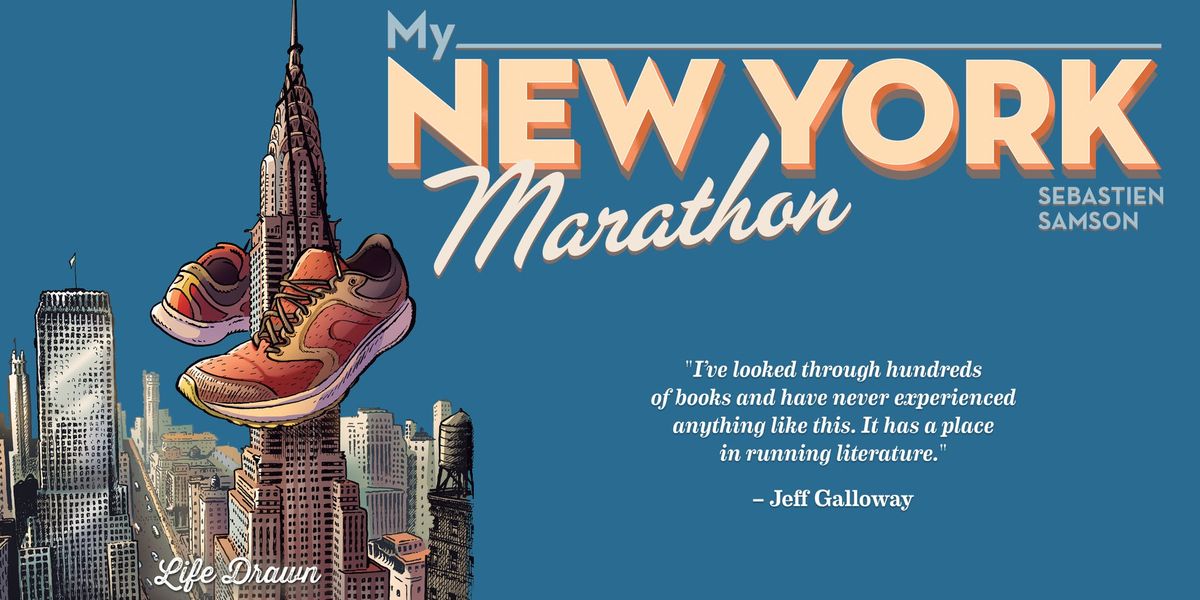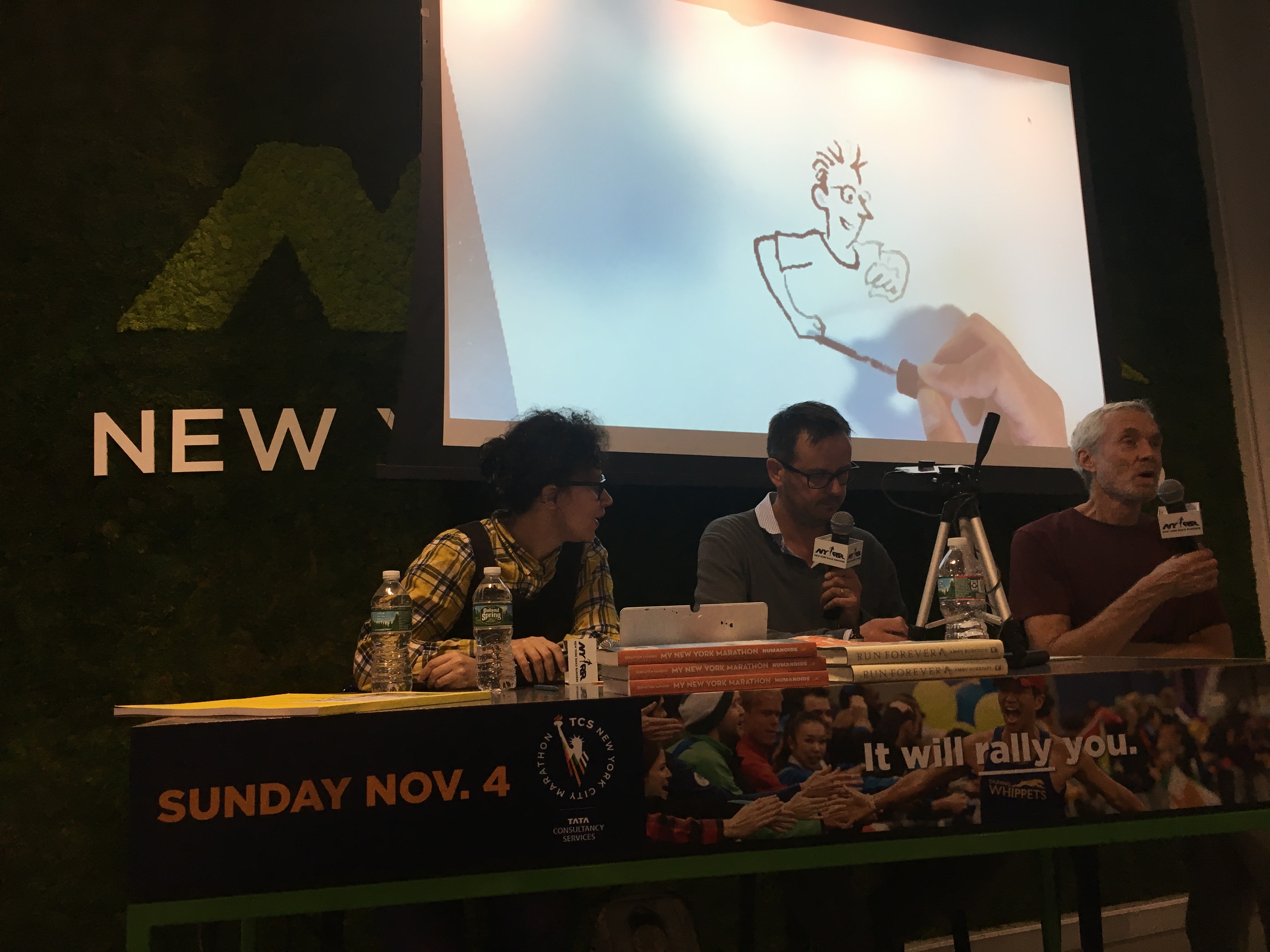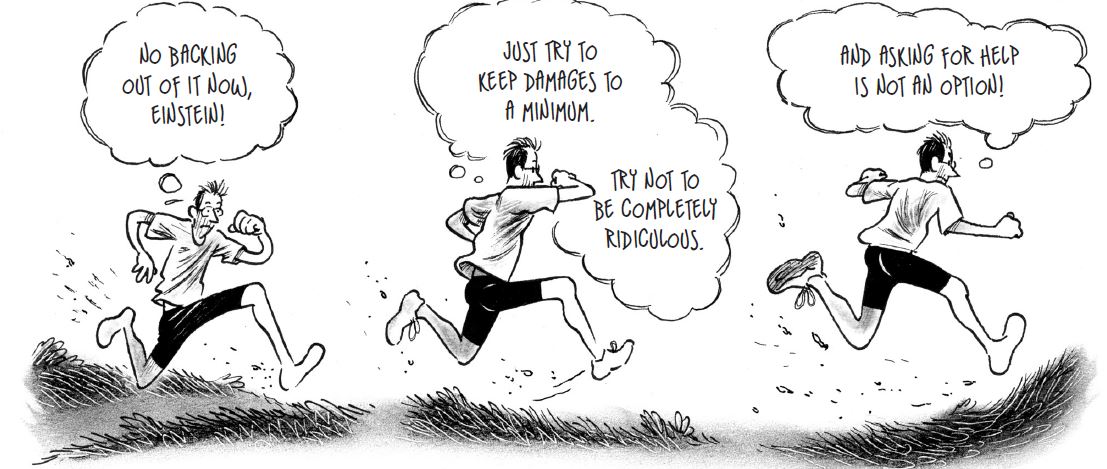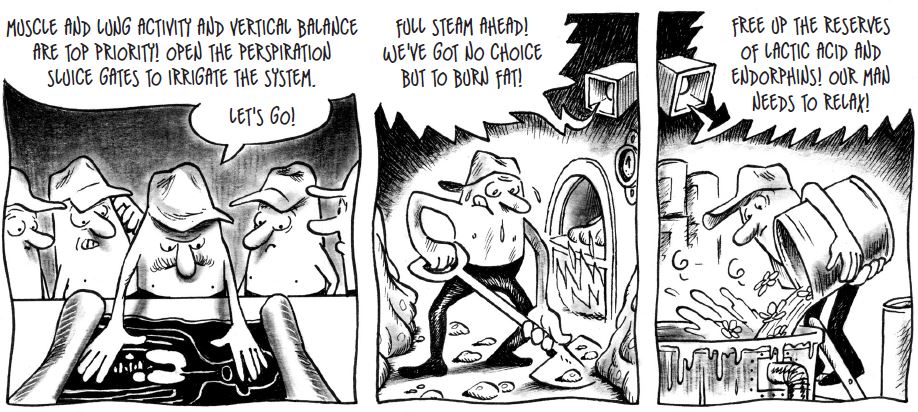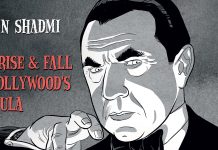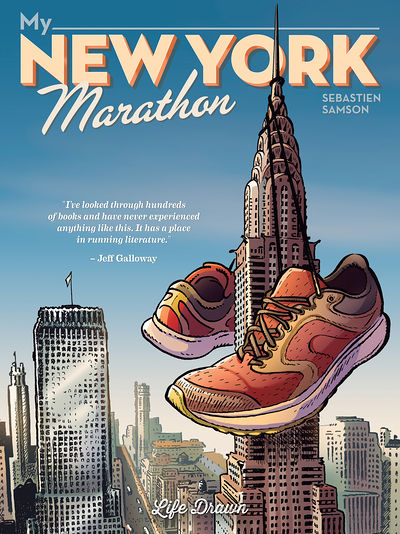
The book presentation took place at the New York Road Runners Run Center in Midtown Manhattan, amidst the sounds of runners talking training routines, footwear, and run times in preparation for the upcoming New York Marathon, which took place on November 4th, 2018. It was featured as part of the TCS New York City Marathon Book Club. Sébastien was joined by Amby Burfoot, former Editor-in-Chief of Runner’s World and winner of the 1968 Boston Marathon (which he ran again this year to commemorate the 50th anniversary of his win); and by Jud Meyers, Director of Sales and Marketing at Humanoids. The presentation featured a live drawing session and a talk focused on Sébastien’s autobiographical book, Burfoot’s most recent book Run Forever, and on how visual storytelling approaches authenticity in a story about running. The event was livestreamed through Humanoids’ Facebook page.
The conversation that developed between Burfoot, Meyers, and Samson covered topics including how comic book storytelling approaches the joys of motion, what the crises of running are, and explored the nuances of physical training specific to marathon running. Burfoot spoke about his feeling of surprise when he read Sébastien’s book and found how authentic the actual running sequences felt, in addition to how the comic presents the process leading up to the run by offering real insight into how people that take on the challenge of a marathon prepare for it. The legendary runner also took the opportunity to comment on the state of running literature, which according to Burfoot relies too heavily on tips and advice for runners in training.
Burfoot considers My New York Marathon an important step in offering different reading experiences that transcend advice and veer more into the realm of introspection, runner identities, and the role of running in life. Jud Meyers made an important observation in this regard when Burfoot spoke to how running is embedded in the evolutionary history of humanity. “We came down from the trees to run,” Burfoot said. Meyers quickly jumped in to remind the audience that we also came down from the trees “to draw on caves and record what we did on those runs.” Comments like these make a strong case to further organize comic book events in places the medium does not have such a commanding presence as, say, spaces where books are the principal point of interest. There is a lot that can be done with this type of event.
My New York Marathon took Sébastien four years to finish. It is a deeply personal but versatile story that plays with brief but very effective metaphorical fantasy elements to address the ways a person’s body changes when it goes through such an intense change in physical routines. Sébastien talked about intentionally slowing down the pace of the running sequences in order to focus on the elements surrounding runners during runs. He wore a GoPro camera on his head to capture the run and then use the footage to help him develop the big marathon sequence.
The book, according to Sébastien, takes a look at the several stages of self-confidence going into running, especially when starting out. The story starts with Sebastién figuring out what running will mean for, beyond the marathon. It develops as a many different things that surround and inform his running. There’s a love story that looks at how running strengthens the bond between him and his wife, in terms of how it further connects their shared experience. There’s a biological aspect to the story that contemplates how one confronts the body’s imperfections and how it informs decisions on whether to continue running or not. There’s also a kind of reflection on running that looks at the roots of one’s own identity and whether it needs to change to accommodate new ways of life. It also looks at goals and how realistic and unrealistic they become throughout each of the different phases of training and personal growth. In this sense, Sébastien states, the book allows for people to see themselves in the amateur runner in him, making him the common person’s runner.
I had the chance to talk to Sébastien on the visual storytelling decisions he made to make sure the book was compelling to readers, regardless of whether they run or not.
Ricardo Serrano: When I read My New York Marathon I was interested in the element of speed. Did you want make a comic that was fast-paced, that captured the sensation of running? Or did you want take your time on each page to focus on the details surrounding the experience of running itself?
Sébastien Samson: The fact it’s a graphic novel excludes the element of speed. I like to take my time, and develop the story and consider all the possibilities. For the part that describes the marathon race itself, in order to convey the race I decided to do away with the panels in order to focus on the possibilities of the blank page.
Serrano: And it’s an interesting approach to the whole sequence. I mean, when you’re reading a prose book, you have to create many of the narration’s images in your head. In your case, you had to illustrate the running process. Do you think that’s easier to capture in comic books rather than in prose books?
Samson: At the beginning my editor told me my writing was too literary and that I had to cut some of the dialogue. My narrative is usually too developed, too literary, too poetic. I had to reduce a lot. When I read a book, I don’t need images at all because you can imagine it all. But what I love about the comics medium is you actually don’t need words. In some cases you can do away with them, focus on the image.
Serrano: In part, that’s what makes comics a difficult medium to approach as a creator. There is a very careful selection process for images, and they can either convincingly support the narrative or hold it back, sometimes to its detriment. Which brings me to authenticity. Given your cartoonish or caricature art style, were you aiming for authenticity in terms of movement or was that something you weren’t worried about?
Samson: There are two things to bear in mind. When I draw my characters, they look European. They are round and they seem elastic. I want them to be expressive. But when I drew the city itself, I did not want to lie. I wanted to give as accurate an image of the city as I could.
Serrano: The city is interesting in that I felt you wanted New York to feel like a character. But also, all of the other places you illustrate in your book, they also have a link to the history of the place. It was something I didn’t expect but was very surprised by.
Samson: One of the reasons I wanted to draw this comic book is related to the mythical status of New York. It’s almost like imaginary to some people, like a phantasm. When I was signing the book, there were two architect friends and we had a conversation and they agreed that I conveyed that aspect of the city very well, the fact that the city had a very mythical quality. There’s a page about Brooklyn, when I drew Park Slope, I didn’t know what the name meant. When I read the American version of the book, I realized I actually drew the park without knowing it was the park. It was a coincidence.
Serrano: I’m interested in the body engineers, the inner-body workers you illustrated that live inside your body. Was that a decision that you struggled with or was it something you set out to do from the beginning? That you wanted to have a little fantasy or that you wanted to play with certain comic book tropes in your story.
Samson: I struggled with this question, actually, for the most part of the writing. One day I went running on the beaches I usually ran on and saw that the idea was just there. It came to me and I said “okay, little characters in my body.” There was narrative problem, actually. If I were to say “right now I’m sweating” or “right now I’m hurting,” it would be harder to convey. For the reader it’s not interesting. But these little characters will make it more interesting for the reader, they will make it funnier, and they will boost the narrative, basically.
Serrano: Since your art style is caricature, your characters are so expressive that they always kept the story moving. That’s why I was surprised with the body engineers because your story is very compelling whether it’s indulging in fantasy or staying closer to realism.
Samson: I’m writing a story about my childhood and I came across the same problem. I created a conversation in that story between the child that I was and the grown-up I apparently am and the whole point is to make the dialogue interesting.
Serrano: I notice that there are instances in the book where one can say you are talking about the philosophy of running. When you talk about the nature of running, that both your body and your legs offer a kind of identity. Where you aiming for something like that?
Samson: Not really. I wasn’t looking to develop a philosophy of running. I am not a specialist. The final chapter was important to me. I wanted to give a reason of why we run. At the beginning of the book, for me, was to lose weight. By the end of the book, it wasn’t that anymore. Each runner has their own philosophy. Mine was connected to a philosophy of roots. I’m very interested in roots, which is why I’m interested in my childhood. I discovered something very ancient in running.
Serrano: Thank you for chatting with me about comics and running and I look forward to your upcoming autobiographical story.
Samson: Thank you!


